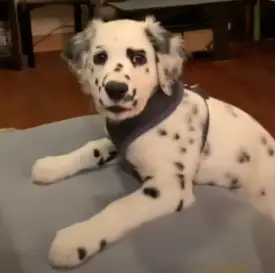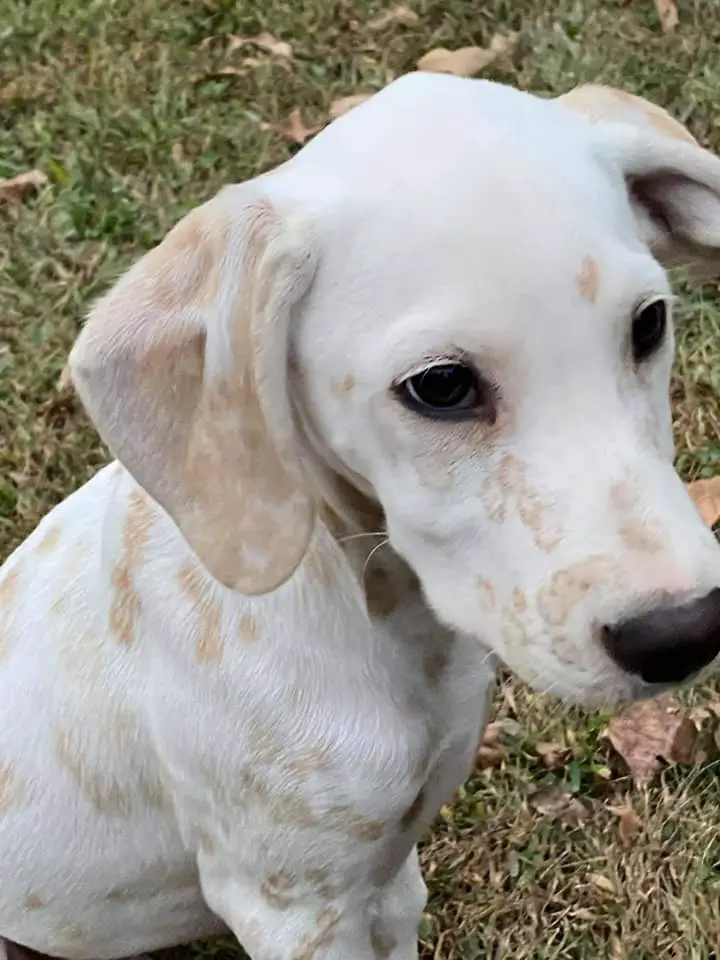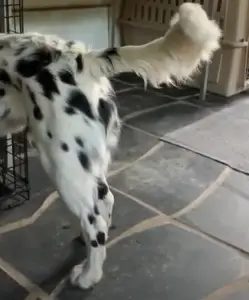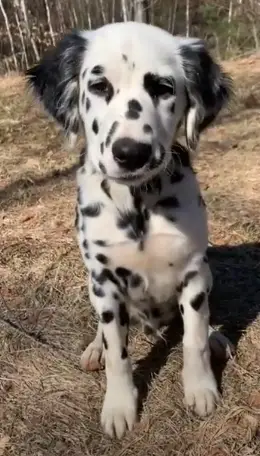The Dalmatian is of those dog breeds that nearly everyone is familiar with in the United States. A favorite among dog lovers, these easily recognizable dogs are the mascot of hundreds of fire stations across the USA. The Long Haired Dalmatian is the longer coated version of the commonly known Dalmatian.
Additionally, they have gained popularity over the years, due cameos in various movies like Marley and Me, Doctor Doolittle 2 and Airbud: World Pup. Also, they have had title roles in the Operation Dalmatian movies, as well as, several different adaptations of Disney’s 101 Dalmatians.
Though many people assume that they are an English dog, their roots go back further than that. Though the origins of the Dalmatian has caused disputes with some experts, ultimately is believed that they came from the Dalmatian region of Croatia.
It was from there that they traveled to Britain before arriving in the USA, where they established themselves and served as carriage dogs running alongside fire engines which were originally carriages before they were modernized into automobiles.
Along with being firehouse dogs, they have served a number of purposes, including as a hunting dog, as well as guard dogs for carriages and coaches attempting to avoid being robbed. This is where they earned their moniker of English Coach Dog or English Carriage Dog. Because of the the physical demands and stamina necessary for these tasks, Dalmatians have been bred to be very energetic dogs.
Also they have been used a war dogs, shepherds and to root out and capture vermin on farms.
Because of the spots, they are also known as Plum Pudding Dogs or Spotted Dick Sponge Pudding, after the English dessert that is flecked with nuts and dried fruit.
The a medium-sized dog with floppy ears, long tails and easily identifiable spots, they can come with one of two different coat lengths, either long or short.
Surprisingly, the original Dalmatians were long-haired but, due to the long coat being unpopular, have been intentionally bred to have shorter coats. Believe it or not, the Long Haired Dalmatian is fairly uncommon.

Long Haired Dalmatians: AKC Breed Acceptance
The American Kennel Club (AKC) is one of the kennel clubs that governs breed specifications. These organizations exist to safeguard the welfare of breeds, keep track of pedigrees and guarantee that show dog rule compliance.
Breed standards are notoriously rigorous when set by organizations like the AKC. And, according to them, the Dalmatian has a short, dense, fine, and close-fitting coat. It is neither fuzzy nor silky. But it should have a smooth, shiny, and healthy.
Ultimately, the Long Haired Dalmatian is not a recognized breed by the AKC.
Even though the long-haired variations have been shown to be purebred Dalmatians, these groups believe it to be the result of a defective gene. The judges will at a show will immediately disqualify a Long-haired Dalmatians!
Long Haired Dalmatian enthusiasts, on the other hand, think that the LC, or long coat Dalmatian, is a real, purebred Dalmatians variation.
Some Dalmatian purists have been overly aggressive in their actions, thinking that by eradicating any indications of this defective gene, they are preserving the purity of the breed. Puppies have even been known to be euthanized to achieve this goal.
Because they are so beautiful, the tide has gradually started to change, albeit they are still uncommon.
Despite the longer hair not being allowed in showing, the AKC has reduced the criteria for participation in agility, dock diving, scent work and obedience contests.
Long Haired Dalmatians are Purebred Dalmatians
As mentioned earlier, long-coat Dalmatians, often known as LC Dalmatians, are purebred. In other words, they have not been bred with other longer coated dogs in order to achieve the long hair.
In order for Dalmatian breeders to capitalize on the increasing popularity and achieve dogs that look like a Long Haired Dalmatian, a Golden Retriever may be mixed with short-haired Dalmatians. Therefore, it is important to choose a reputable breeder.
Even more perplexing is the fact that Dalmatians with long coats are permitted to compete in agility trials and may even be registered with specific Kennel Clubs. However, as mentioned, they aren’t allowed to compete in shows because of breed requirements!
Genetics of a Long Haired Dalmatian: How did a Dalmatian acquire a long coat?
The long, silky hair is caused by a recessive gene, which means that a dominant gene normally obscures it. When both parents with the recessive gene breed, there is a chance that the offspring may have long coats.
Unfortunately, as the long-haired gene became undesirable, breeders started preferentially breeding short-haired Dalmatians once short hair established a breed standard.
Long Haired Dalmatian: Do They Shed?
All Dalmatians shed year-round but they are not heavy shedders.
The hair tends not to stay on fabric, so it won’t cling to your clothes and soft furnishings, but it is incredibly smooth and soft to the touch. Additionally, it’s rather simple to vacuum or sweep up debris from carpets or laminate flooring.
It’s a good idea to brush your dog every other week to keep shedding and knots under control. Feeding them high-quality dog food also helps prevent hair loss since it keeps their skin and coat in good condition.
What is meant by “long hair” or “long coat” is that this silky fur will grow 2 to 4 inches from the body, which differs greatly from the short hairs on the “regular” Dalmatian.
Additionally, they have feathering on their ears, legs, and tail, which as they age can grow up to 4-6 inches long.
Long Haired Dalmatian: Coat Variations
All color options of a standard Dalmatian are offered in the Long-haired Dalmatians fur coat. The Dalmatian with a coat with black spots is the most prevalent, followed by the Dalmatian with a long, liver (brownish red) coat.
In addition to those common hues, you can also find Long-haired Dalmatians in brindle (spots are black and brown mixed in), tricolor (black, brown and tan individual spots), and lemon. A genetic mutation results in the long-haired Lemon Dalmatian, a very uncommon Dalmatian coat.

Among these colors, only the black and liver are recognized by the AKC; the blue, brindle, lemon, and tricolor are considered undesirable. The choice of coat color is yours, though, as the AKC does not accept Dalmatians with long coats.
Long Haired Dalmatians: Allergies in Humans
Given that pet allergies are frequently tied to shedding, this question is related to the prior one. They are not hypoallergenic, is the explanation.
This does not necessarily mean that people with dog allergies should not consider them. Pet allergies aren’t caused by the hairs themselves but rather by salivary proteins and dander, which are dry flakes of skin that stick on and between a dog’s fur.
Breeds known for being hypoallergenic, like the Poodle, don’t produce a lot of dander and have a single coat that doesn’t shed a lot. The curly coat traps any stray hair, preventing it from falling out around the house and allowing it to be brushed out.
Additionally, the term “hypoallergenic” merely suggests that you have a lower chance of experiencing an allergic reaction. There are no promises made! While you may be sensitive to one breed, you won’t necessarily be allergic to another because different breeds create different allergens.
Long Haired Dalmatian: Temperament
These dogs are renowned for their loyalty, friendliness, and playful personalities. For the appropriate family, they make a good family pet.
As they are high-energy dogs, they will fit in well with an athletic, outgoing family who enjoys taking long excursions and walks in the hills and woods. They have a strong constitution and can walk for long distances without getting tired.
To get the most out of them, they need socialization and proper training, but if you’re prepared to make the investment, you’ll have a friend for life. They make great watchdogs and will defend you and your property.
Dalmatians may exhibit hostility toward other dogs and be apprehensive of strangers, which is why socializing early in life is so crucial.
These dogs are alert and perhaps even act “caffeinated.” A family with small children may reconsider having a young Dalmatian due more to physical injury from a over-active, developing puppy. With the exception of this caution, these spotted dogs get along well with children and are typically very patient
.
However, it is always advisable to watch over any dog when kids are present.
Long Haired Dalmatian: Cost
The cost might still be rather high even though these dogs are not acknowledged as a true member of the Dalmatian breed.
For a long-haired Dalmatian puppy, the price might still be between $800 and $1,200. Your location, the availability and demand in your neighborhood, and the breeder’s reputation will all affect the price.
Remember that breeding is a costly procedure even though that may seem a bit excessive. In fact, it’s likely that many of the litters produced by reputable, established breeders will result in a loss.
For instance, the price of DNA testing alone can reach $1,000 each litter. This is before the cost of stud fees, feeding, kennels, whelping supplies, immunizations, and a host of other overhead expenses!
Miniature Long-Haired Dalmatians
A long-coat Dalmatian in small or dwarf form is known as a mini Long Haired Dalmatian. Experts think that the long-haired, mini Dalmatian isn’t a pure breed because long-coat Dalmatians often come in a standard medium size.
Breeders typically cross a long-coated Dalmatian with a smaller dog breed to produce miniature Long-haired Dalmatians.
Here are some things to think about before moving forward with a miniature:
• Some breeders develop mixed-breed by mating a purebred dog with another, smaller breed to produce miniature dogs. While this may be advantageous because it may breed out undesirable qualities, it makes it more challenging to forecast certain characteristics of the hybrid.
• Runts from the litter are used by unethical breeders to produce small dogs. Runts can often have health issues that they can possibly pass down to their offspring for generations to come.
• Horribly, a few breeders actually deprive the puppies of necessary nutrients in order to maintain their underweight and underdeveloped state in order to stunt their growth and to make them appear smaller all together.
It is best to interview and investigate any breeder that you are considering purchasing a puppy from.
Long Haired Dalmatian: Life Expectancy
Though not always the case, it is common that a dog’s lifespan is shorter the larger it is. They are believed to age more quickly because of how swiftly they grow.
They are susceptible to certain health problems, like all dog breeds, but with the correct care, they should enjoy long, healthy lives.
The lifespan of Long-haired Dalmatians is equivalent to that of short-haired Dalmatians. Although they can live up to 16 years, the average lifespan of a medium-large breed dog is 11 to 14 years.
LC Dalmatians: Health Problems
Hyperuricosuria/Kidney Stones/Bladder Stones
Of all of the health conditions in Dalmatians this issue is more prevalent in male LC Dalmatians because of their narrow urinary tracts.
Their food intake is very important. Dalmatian dogs need to eat a low-purine diet to keep their uric acid level in control and by ensuring that your dog always has access to fresh, clean water.
Hyperuricosuria is when the dog’s body produces uric acid in excess. High production of uric acid leads to gout, kidney stones, and bladder stones. These stones form because they are unable to process purines (organic compounds in food).
Also, you may ask your veterinarian about a Quercetin supplement that has been known to help regulate Uric acid in humans and is known to be safe for dogs. Quercetin has also been known to be good for dog allergies
Some breeders have begun to use dogs with two LUA (Low Uric Acid) genes, meaning that their pups will have normal levels of uric acid and be less prone to these health problems.
Dalmatian Deafness
Deafness is another health issue that is common in Dalmatian dogs. Up to 30% of all Dalmatian puppies are believed to be born deaf in at least one or both ears.
This problem is connected to the gene that creates the distinctive white coat with black spots. All Dalmatians carry the piebald gene, which is responsible for their appearance. Extreme piebald in these dogs can lead to congenital deafness in one or both ears.
On the other hand, deafness is considered a desirable trait for firehouse dogs as their ears won’t be afflicted with the same pain as dogs with sensitive ears. In other words, they won’t be affected by the loud sirens. Many dogs lose their hearing as they age and will need special training.
Epilepsy
There are several causes of epilepsy in dogs, including trauma, organ failure, and poisoning.
However, this particular form of epilepsy shows no evidence of these symptoms and it is believed that the cause is pre-existing or hereditary chemical defect in the brain. This is known as idiopathic epilepsy, and it is managed through the use of drugs.
Atopy (Contact Dermititis)
The main culprits of allergies in dogs are food, pollen, molds, yeast, fleas and dust mites. With these allergic reactions, a dog’s immune system can overreact and they may develop dry, itchy skin.
The main areas that these develop are on the feet, face, armpits and groin.
These allergy symptoms can be treated with corticosteroids, antihistamines, antibiotics, antifungals and/or supplements to boost the dog’s immune system. According to Dogs Naturally Magazine Quercetin can be a good supplement for dog allergies.
You may recognize this from the Hyperuricosuria entry from above. It’s always nice when a supplement helps with more than one ailment.
Hypothyroidism
Dalmatians—both short and long Haired—are prone to hypothyroidism. This condition arises when the dog’s thyroid gland cannot release enough thyroid hormone in the blood. This deficiency often leads to weight gain, lethargy, hair loss, skin infections, and muscle weakness.
According to the FDA, there is no cure for Hypothyroidism in dogs but it can be treated with medication.
Hip and Elbow Dysplasia
A common problem in many breeds, especially larger dogs, hip dysplasia, is a painful condition formed as the dog grows. The hip joint is loosened and as the dog ages, the bones in the joints grind together making normal movements very painful.
The joint then becomes inflamed, leading to arthritis. Depending on the severity of the problem, a vet may recommend surgery, replacing the entire joint with a steel and plastic one that works smoothly and painlessly.
At the very least, pain medication may be prescribed.
Other Bone and Joint Conditions
Long-haired Dalmatians suffer from bone degeneration and arthritis in their old age. Conditions like bone spurs, joint deterioration can lead to painful geriatric years.

Long Haired Dalmatian: Grooming
Even though they shed exactly as much as their short-haired counterparts, Long-haired Dalmatians need more maintenance due to their longer hair.
To maintain their hair lustrous and free of tangles, brush their coat with a glove brush and a vacuum cleaner at least twice or three times every week.
Additionally, it’s crucial to prevent their hair from getting too long. Regular grooming is necessary to prevent hair on their footpads from impairing the dog’s grip on slick surfaces.
Bathe your Long Haired Dalmatian once a month or more often if it smells. However, as with any dog, bathing your dog too frequently would remove the natural oils from its skin and can make it dry.
Long Haired Dalmatian : Nutrition and Diet
Some Dalmatians produce too much uric acid, in which case they would require a particular low purine diet to prevent their uric acid levels from getting too high.
The Long Haired Dalmatian prefers the meats of chicken and whitefish. But it’s crucial to counterbalance them with nutritious vegetarian ingredients. We advise you to approach your veterinarian to establish a feeding regimen for your Lon Haired Dalmatian.
Additionally crucial is hydration. Distilled water rather than tap water is preferable. With purified water, minerals and salts won’t enter the dog’s system and cause deposits.
Long Haired Dalmatian : Exercise and Training
The care and training of a Long-haired Dalmatian are essential. These dogs are known for having high energy level, and if they aren’t exercised, they may become rather destructive.
Early training is necessary for them to become good family dogs. In order to assist them burn off their additional energy, they need to have an active lifestyle.
Fortunately, these dogs are intelligent and eager to please their masters, making training extremely simple.
Dalmatians are well known for their tenacity. They used to run for kilometers alongside coaches back in the day. Naturally, a dog of this breed won’t be content with small neighborhood strolls.
To satisfy their high energy level, the Long Haired Dalmatian needs 1.5 to 2 hours of movement per day. Divide these sessions into two if possible. This dog will have no issue keeping up with your family’s active lifestyle throughout the day.
Your LC Dalmatian will adore enrichment games like fetch, frisbee, and ball games.
Long Haired Dalmatian : Reputable Breeders
LC Dalmatians and their short-haired counterparts alike have fallen victim to these unscrupulous breeders at various times over the past five decades or so when this breed was thrust into the limelight. In 1961, Disney’s 101 Dalmatians made them the dog that everyone had to have. And this has become true each time a new movie was released.
Just like any breed that is in a popular movie or TV show gains in popularity, back yard breeders and puppy mills saw a chance to make money. They used poor breeding practices and unhealthy or unsuitable stock, which still affect the breed today.
As a result, and what commonly happens, rescue centers and dog shelters were overwhelmed with young adult Dalmatians in the year or two following each movie release. Not everyone could handle the energy of a young Long Haired Dalmatian and deafness caused even more difficulties. Misunderstandings occurred.
Dogs with hearing problems were often startled by the owners or their families because they wouldn’t hear them. They were seen as difficult to train or even stupid.
When the deaf dog reacted badly when startled, they were written off as being too aggressive, which was made worse by ignorant or lazy dog owners that did not take the time to invest in obedience training and socialization.
Unfortunately, even to this day, some people consider the long hair Dalmatian to be a difficult dog because of this. However, the truth is that a well-trained, properly socialized Dalmatian that comes from a reputable breeder makes an exceptional companion dog for the right person or family.
The Bottom Line on the Long Haired Dalmatian: A Summary
The Long Haired Dalmatian, other than coat length, is the same as it’s short haired counterpart. These beautiful dogs are just as beautiful (and fluffier) and are on par with the cuteness of a Golden Retriever, a Labradoodle or a Goldendoodle.
It’s a smart, energetic and family friendly dog that with the right training can also do various other tasks.
We hope that soon the AKC will accept the longer coat and it will be seen as a desirable trait.

